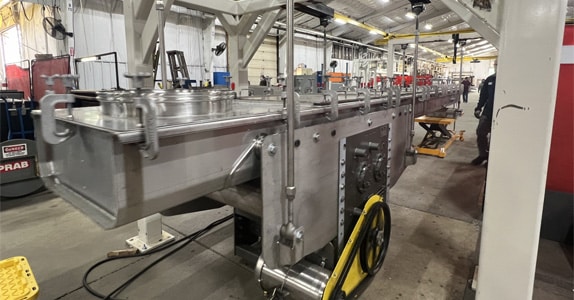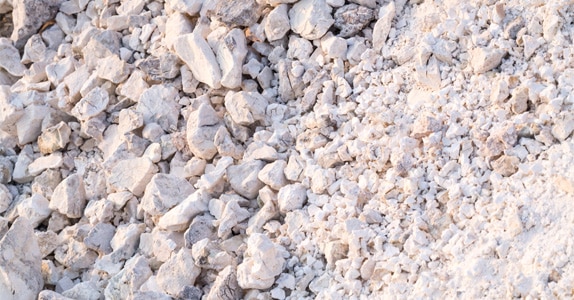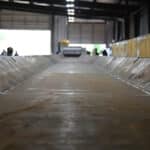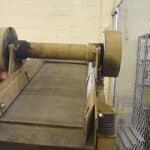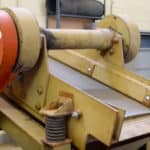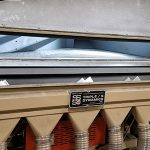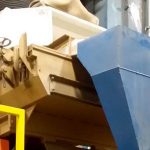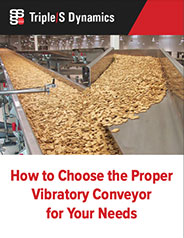Belt And Vibrating-trough Conveyors: Some Guidelines For Selection
Choosing a mechanical conveyor that can successfully handle your material and operating requirements isn’t easy. And when your project budget is tight – a common situation in today’s bulk solids plants – the decision can become even more complex. This article provides practical advice for selecting a belt or vibrating-trough conveyor that will meet your needs and operate economically over the long term.
Belt conveyors and vibrating-trough conveyors are some of the most widely used mechanical conveyors in bulk solids handling operations. These conveyors are available in various configurations and operating modes to handle a wide range of materials, transfer distances, and conveying rates.
To choose a belt or vibrating-trough conveyor for your application, you need to consider basics like the conveyor’s capital cost, your plant’s available space, and whether the conveyor can successfully transfer your material at the rate you need. You’ll also need to determine what short- and long-term maintenance the conveyor will require and how that will affect the unit’s operating costs over its service life. The following information can help you weigh these factors for three common belt and vibrating-trough units: standard belt, inclined-motion vibrating-trough, and horizontal- motion vibrating-trough conveyors. [Editor’s note: For more detailed information about these and other mechanical conveyors, see the “For further reading” section later in this article.]
Standard belt conveyor
A standard belt conveyor, as shown in Figure I, basically consists of an endless flexible belt supported by rollers and one (or more) pulley driven by a motor. The belt conveyor is by far the most widely used, economical conveyor for transferring medium to large (about 0.5- to 6-inch) particles at near-ambient temperatures from 10 to several hundred feet. The conveyor typically can elevate or lower material up to 20 degrees from horizontal without requiring a specialized belt that has nights or ribbing. Material remains stationary on the belt over the entire conveying distance, whether the conveyor is moving along a level horizontal path or an inclining or declining path, With a belt speed commonly up to 300 fpm, the conveyor can transfer materials at rates from a few thousand pounds per hour to hundreds of tons per hour.
The standard belt conveyor is available in a variety of lengths, widths, and configurations and with light -,medium -, or heavy-duty construction. Installing the conveyor is usually simple and requires little or no plant support structure, which has the advantage of allowing the conveyor to be modified rather than replaced when conveying needs change. Rather than being fully enclosed, the standard belt conveyor usually has an overhead cover and a catch pan below the belt return to provide easy access and limit the unit’s capital cost. The unit is typically supported or suspended (or a combination of both) at between 8 and 20 feet apart.
The conveyor doesn’t vibrate, so it doesn’t require installation with vibration isolation media. In some cases, depending on the belt type and conveyor length, the drive pulley can be located at either end of the conveyor and the conveyor can operate in reverse. While a short belt conveyor can be started and stopped frequently, stopping a longer unit requires dynamic braking (applying an external force to quickly stop the conveyor), and frequent stops can lead to electrical problems.
Maintenance and costs. While the standard bell conveyor typically requires little maintenance in the first year, it requires more service in the following years, typically for problems with belt stretching, belt tracking (from belt misalignment), worn lagging (wear to the material covering the rollers and pulleys), and bearing failure. The standard belt conveyor has a lower capital cost than vibrating-trough conveyors but costs more to operate and maintain over the long term, especially in sanitary handling applications. This is because cleaning material carryover off the belt (even a sanitary belt) is more difficult than cleaning a trough, and removing the carryover requires adding belt cleaners and related accessories to the conveyor. Debris and dust from the carryover can also get into the belt conveyor’s moving parts, leading to more frequent maintenance. If debris lodges between the belt and pulleys, the belt can travel off-track, which is not only a nuisance to correct but can damage the belt and eventually cause it to fail. Choosing a belt conveyor equipped with a belt self-tracking device or a hybrid belt material equipped with cogs to provide a positive drive mechanism can reduce belt tracking problems, but these features also increase the conveyor’s capital cost.
Selection guidelines. The standard belt conveyor may be best for your application if: • You need a high conveying rate.
- You need to convey over a very long distance.
- Your plant has limited structure for supporting (or suspending) the conveyor.
- A lower capital cost is more important than the conveyor’s long-term operating and maintenance costs.
- Your material doesn’t require sanitary handling.
Inclined-motion vibrating-trough conveyor
An inclined-motion (or pitch) vibrating- trough conveyor consists of a rigid (typically stainless steel or carbon steel) the trough that’s horizontal, slightly inclined. or slightly declined and supported by a vibrating drive system, as shown in Figure 2.The drive system is mounted on (or suspended from) a vibration isolation medium, commonly consisting of rubber (or a similar material) or a set of metal coil springs, The vibrating trough provides an inclined motion points that pitches the material forward with a sinusoidal (that is, smoothly oscillating) lofting action that stratifies the material so that smaller particles silt to the trough bottom.
The inclined-motion conveyor can transfer materials of virtually any particle size while providing specialized handling, including classifying materials by particle size, screening unwanted particle sizes from materials, reducing surface moisture of wet materials, and regulating material feedrate. In addition, when a free-flowing material with small to medium particles has been unevenly loaded onto the trough, the conveyor’s vibration will evenly distribute the material to provide a uniform discharge rate to the downstream process. The conveyor isn’t suitable for handling fragile or coated materials, because its pitching motion tends to damage fragile particles and knock off coatings.
The inclined-motion vibrating-trough conveyor can be configured for inclines or declines up to 5 degrees from horizontal, depending on the application, and can be designed to handle materials with temperatures over 500°F. The vibrating drive system can be located at either end of the conveyor and either above or below it, but the conveyor typically can’t be operated in reverse. Since this conveyor vibrates, it must be supported or suspended (or a combination of both) at points generally 8 feet apart or less to prevent the trough vibration from resonating with the support system’s natural frequency. The conveyor can be enclosed to prevent dust from escaping in to the environment or to control the atmosphere inside the conveyor.
The conveyor trough can be configured to vibrate in one of two ways: forced frequency or natural frequency.
Forced-frequency unit. The trough of a forced-frequency conveyor is attached to mechanical or electromechanical exciters that are mounted on a vibration isolation medium. The unit typically transfers material less than 15 feet but can operate over a wide speed range, providing feedrates up to 80 fpm. Compared with the natural-frequency conveyor, the forced -frequency unit has a much smaller trough stroke, making it less suitable for transferring material at an incline or screening material. Like the standard belt conveyor, the inclined-motion forced- frequency conveyor can be used in applications with frequent starts and stops, but stopping a longer unit requires dynamic braking, and stopping frequently can lead to electrical problems.
Maintenance: The forced-frequency conveyor’s only moving parts are the exciters, so the conveyor requires little maintenance. For a smaller forced-frequency conveyor, the only required maintenance is periodically inspecting the exciters and vibration isolation medium; for a larger unit, maintenance also includes periodically lubricating the exciters. When the conveyor is continuously operated in a normal rather than hostile (such as dusty or extremely hot or cold) environment, the vibration isolation medium will require replacement every 5 or more years.
Costs: The forced-frequency conveyor’s smaller size gives it a relatively low capital cost, but the conveyor can consume a lot of power.
Natural-frequency unit. The trough of a natural-frequency conveyor rests on a support system with power springs that are mounted on a vibration isolation medium. The trough support system, which can be belt-driven by an electric motor or a motor with eccentric weights, operates at a tuned frequency and provides a larger pitching action than a forced-frequency conveyor. So it requires less power for conveying. The natural-frequency conveyor can move materials up to 100 feet and typically operates at up to 40 to 60 fpm, but can run at up to 80 fpm when declined. This conveyor has a narrower speed range than the forced-frequency unit, so the natural-frequency conveyor is often provided as a fixed-speed conveyor. Depending on the design of its trough support system, the conveyor can be stopped quickly, allowing it to be used in applications with frequent stops and starts.
Maintenance: Required maintenance includes inspecting the drive belt (when the trough support system is belt-driven) and the vibration isolation medium. As with the forced-frequency unit, the vibration isolation medium’s average life span under normal conditions is 5 or more years. If the conveyor’s operating speed or trough mass has been modified, the support system must he returned to provide the required vibration.
Costs: Although it has a lower operating cost than a forced-frequency conveyor, the larger natural- frequency conveyor typically has a much higher capital cost.
Selection guidelines. Either the forced- or natural-frequency vibrating-trough conveyor may be best for your application if:
• Your material is wet or sticky.
• You need to spread your material across the conveying surface to provide uniform feed to a dryer or cooler.
The natural-frequency vibrating-trough conveyor may he best if:
• You need to convey your material uphill or downhill at up to 5 degrees from horizontal.
• You need to screen your material by particle size during conveying.
• Your application requires frequent starts and stops.
Horizontal-motion vibrating-trough conveyor
A horizontal-motion vibrating-trough conveyor, as shown in Figure 3, typically consists of a stainless steel or carbon steel trough mounted on a support system with a drive mechanism that imparts a horizontal, slow- forward, quick-return (that is, differential) motion to the trough. The friction-based conveyor shuffles the material along the trough at a relatively low speed. typically from about 25 to 40 fpm, and can handle materials of any particle size.
Depending on the trough size (that is, the trough’s width and depth, or cross-sectional area), the conveyor can transfer material more than 200 feet. The conveying distance is limited by the compressive and tensile forces the trough is subject to; the longer the conveyor, the higher these forces will be. The trough can also be sized to handle surge requirements, such as accumulating and storing material for periodic release to a downstream process.
The conveyor’s gentle differential motion tends to deaerate material, preventing it from stratifying or being damaged. This motion can be imparted by an inertia drive, with weights that spin inside a housing and are belt-driven by an electric motor, or by a motor-driven mechanical device connected to the trough. The horizontal-motion unit can be designed to handle materials at 500°F or higher and can be enclosed to prevent dusting or control the conveying environment.
The horizontal-motion conveyor’s friction-based operation typically limits its use to horizontal conveying or inclined or declined conveying of 2 degrees from horizontal or less. The conveyor can be supported or suspended (or a combination of both) at points up to 20 feet apart, with the drive mechanism at either end of the trough and either above or below it. These minimal support requirements allow the trough to be located under other equipment, just inches off the floor, or to pass through a relatively small wall opening.
The conveyor’s drive speed can be varied to control the conveying rate. However, to avoid unwanted speed excursions, the conveyor shouldn’t be operated in the speed range of the support system’s natural frequency. The conveyor can also be operated in reverse, but, like the standard belt conveyor and inclined-motion forced-frequency conveyor, requires dynamic braking 10 provide quick stops, making it less suitable for an application requiring frequent stops and starts.
Maintenance and costs. Required maintenance for the horizontal-motion conveyor includes periodically lubricating the drive bearings and inspecting the support system and drive belt. The average life span of the conveyor’s support (or suspension) components when the unit operates continuously and in a non-hostile environment is 5 years or more.
The horizontal-motion conveyor’s capital cost can be high for relatively short transfer distances but very economical at longer distances, Its energy consumption is similar to that of a standard belt conveyor or inclined-motion natural-frequency conveyor of equivalent capacity.
Selection guidelines. The horizontal-motion vibrating trough conveyor may be best for your application if:
• Your material is fragile, coated, dusty, or agglomerated.
• Your material’s temperature varies widely.
• You need to accommodate large material flow surges.
• You have limited space for the conveyor and its support system.
• You need to convey at variable speeds or in reverse.
For further reading
Find more information on these and other mechanical conveyors in articles listed under “Mechanical conveying” in Powder and Bulk Engineering’s article index (in the December 2013 issue and at PBE’s website. www.powderbulk.corn) and in books available on the website at the PBE Bookstore. You may also purchase copies of previous PBE articles at www.powderbulk.com.


